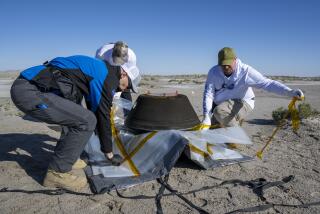Astronauts Grab Satellite and Avoid Hitting Another
- Share via
KENNEDY SPACE CENTER, Fla. — In a risky maneuver requiring precision flying, space shuttle Columbia’s astronauts retrieved one satellite Monday night while avoiding being rear-ended by another in swift pursuit.
The crew reached out with a robot arm and deftly snagged the saucer-shaped satellite as all three spacecraft sped along at more than 17,000 mph.
The rendezvous was moved up three hours because a telescope trailing the shuttle and saucer had been gaining on them faster than expected.
The two satellites were dropped off by Columbia’s astronauts last week. The two-ton saucer was used to grow semiconductor film in the ultra-clean vacuum of space; the 3.5-ton ultraviolet telescope is looking at stars and galaxies.
After three days leading an orbital procession stretching up to 75 miles, Columbia leapfrogged backward to a point nine miles behind the saucer and seven miles ahead of the telescope. Then, the shuttle commander, Kenneth Cockrell, guided the shuttle in for the capture 220 miles above the South Atlantic.
Mission Control lost communication several times with Columbia during the final, critical hour of the rendezvous because of problems occurring with one of NASA’s tracking and data-relay satellites. Contact was restored just in time for the grab.
To avoid a catastrophic collision, Mission Control considered sending the astronauts after the saucer a day early to give them a wider margin of safety. But after recalculating the projected distances, NASA concluded the speeding telescope would be far enough back.
This was the first mission in which a shuttle flew in formation with two satellites.
Columbia’s five astronauts released the saucer, called a Wake Shield, on Friday. That night, Mission Control and the astronauts watched nervously as the steel disk drifted to within 10 feet of Columbia’s cockpit. But it backed off, and the danger passed.
Semiconductor film just one-tenth the thickness of a human hair was grown atom by atom on the back of the Wake Shield in the vacuum created in the saucer’s wake.
Scientists grew seven wafers of film--the first time they accomplished all their objectives. The first two flights of the Wake Shield, in 1994 and 1995, were marred by satellite malfunctions.
Researchers will not know the purity of the samples until after Columbia lands on Dec. 5, but they said the film should be superior to that produced on Earth. It will be tested in transistors and other electronics.
The telescope, meanwhile, will be retrieved by the astronauts on Dec. 3.






